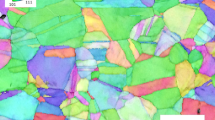Abstract
In this work, the small lateral-compression testing based on energy equivalent (SLT-EE) method is put forward to determine the stress–strain curves of materials utilizing small disk specimens. Numerical simulations of small lateral-compression testing with imaginary materials are conducted to examine the validity of the SLT-EE method. The results demonstrate that the stress–strain curves determined by the SLT-EE method coincide with the curves input by finite element analysis. In order to predict the stress–strain curves of materials with different dimensions, a modified SLT-EE method is successfully proposed by introducing a correction factor f. Finally, the small disk compression experiments of Q345B, 304, 7075 and 6061 are performed. The stress–strain curves of the four materials predicted by the SLT-EE method show agreement with the tension results. Furthermore, the mechanical properties of in-service hollow components are also determined utilizing the same method successfully.














Similar content being viewed by others
References
Zhao Y, Guo Y, Wei Q, Dangelewicz A, Xu C, Zhu Y, Langdon T, Zhou Y, Lavernia E. Influence of specimen dimensions on the tensile behavior of ultrafine-grained Cu. Scr Mater. 2008;59(6):627–30.
Wen W, Jackson GA, Li H, Sun W. An experimental and numerical study of a CoNiCrAlY coating using miniature specimen testing techniques. Int J Mech Sci. 2019;157–158:348–56.
Han W, Yabuuchi K, Kasada R, Kimura A, Wakai E, Tanigawa H, Liu P, Yi X, Wan F. Application of small specimen test technique to evaluate fracture toughness of reduced activation ferritic/martensitic steel. Fus Eng Des. 2017;125:326–9.
Bao C, Cai L, He G, Dan C. Normalization method for evaluating J-resistance curves of small-sized CIET specimen and crack front constraints. Int J Solids Struct. 2016;94–95:60–75.
Hyde T, Hyde C, Sun W. Theoretical basis and practical aspects of small specimen creep testing. J Strain Anal Eng Des. 2013;48(2):112–25.
Olbricht J, Bismarck M, Skrotzki B. Characterization of the creep properties of heat resistant 9–12% chromium steels by miniature specimen testing. Mater Sci Eng A. 2013;585:335–42.
Liu H, Shen Y, Yang S, Zheng P, Zhang L. A comprehensive solution to miniaturized tensile testing: specimen geometry optimization and extraction of constitutive behaviors using inverse FEM procedure. Fus Eng Des. 2017;121:188–97.
Kumar P, Dutta BK, Chattopadhyay J, Shriwastaw RS. Numerical evaluation of J–R curve using small punch test data. Theor Appl Fract Mech. 2016;86:292–300.
Kameda J, Mao X. Small-punch and TEM-disc testing techniques and their application to characterization of radiation damage. J Mater Sci. 1992;27:983–9.
Konopík P, Dzugan J, Prochazka R. Determination of fracture toughness and tensile properties of structural steels by small punch test and micro-tensile test. Metal Brno Czech Repub. 2013;5:15–7.
Dobeš F, Dymáček P, Besterci M. Estimation of the mechanical properties of aluminium and an aluminium composite after equal channel angular pressing by means of the small punch test. Mater Sci Eng A. 2015;626:313–21.
Husain A, Sehgal DK, Pandey RK. An inverse finite element procedure for the determination of constitutive tensile behavior of materials using miniature specimen. Comput Mater Sci. 2004;31:84–92.
Penuelas I, Cuesta II, Betegon C, Rodriguez C, Belzunce FJ. Inverse determination of the elastoplastic and damage parameters on small punch tests. Fatigue Fract Eng Mater Struct. 2009;32:872–85.
Yang S, Cao Y, Ling X, Qian Y. Assessment of mechanical properties of Incoloy800H by means of small punch test and inverse analysis. J Alloy Compd. 2017;695:2499–505.
Chen H, Cai L. Unified elastoplastic model based on a strain energy equivalence principle. Appl Math Modell. 2017;52:664–71.
Peng Y, Cai L, Chen H, Bao C, He Y. A novel semi-analytical method based on equivalent energy principle to obtain J resistance curves of ductile materials. Int J Mech Sci. 2018;148:31–8.
Peng Y, Cai L, Chen H, Bao C. A new method based on energy principle to predict uniaxial stress–strain relations of ductile materials by small punch testing. Int J Mech Sci. 2018;138–139:244–9.
Kazakeviciute J, Rouse JP, De Focatiis DS, Christopher JH. The development of a novel technique for small ring specimen tensile testing. Theor Appl Fract Mech. 2019;99:131–9.
Chen H, Cai L, Bao C. Equivalent-energy indentation method to predict the tensile properties of light alloys. Mater Des. 2018;162:322–30.
Chen H. The theory based on mean-value energy equivalence and the small specimen testing methods for materials. Chengdu: Southwest Jiaotong University; 2019.
Acknowledgements
The authors gratefully acknowledge the financial support from the key projects of the National Natural Science Foundation of China (Grant No. 11632001) and the innovative development foundation of Chinese Academy of Engineering Physics (Grant No. PY20200046).
Author information
Authors and Affiliations
Corresponding author
Rights and permissions
About this article
Cite this article
Peng, Y., Jia, D., Wang, L. et al. Determination of the Uniaxial Stress–Strain Relations of Ductile Materials by Small Disk Specimens. Acta Mech. Solida Sin. 34, 252–262 (2021). https://doi.org/10.1007/s10338-020-00205-9
Received:
Revised:
Accepted:
Published:
Issue Date:
DOI: https://doi.org/10.1007/s10338-020-00205-9




